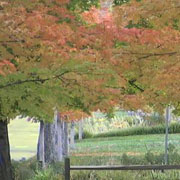-
(单词翻译:双击或拖选)
Autumn Leaves Show Their True Colors
As days grow shorter and nights grow cooler in Boulder1, Colorado, the green leaves of summer have been putting on party colors.
On cottonwood trees and aspens, they’re golden yellow coins. On Mapleton Avenue, the maple2 trees are sunset shades of orange and red.
The same seasonal3 phenomenon occurs in many countries in late autumn, yet people don't always know the reason leaves change color when the weather gets cooler.
Fall splendor4
Some do have their theories about the autumnal transformation5.
“I’ve heard that the reason why the leaves change throughout the seasons is because God likes to see different colors all over the world," says one girl, "so that he can tell what season it is.”
“According to legend," says a woman, "three hunters and their dog chased the Great Bear into the sky, slaughtered6 it and its blood dripped onto the leaves, turning them red.”
Dave Sutherland, a naturalist7 with Boulder Mountain Parks, recalls the explanation he heard in childhood. “My mom told me it was because at night, when everybody’s asleep the fairies come out and paint them.”
Magical science
It turns out the scientific explanation for why leaves change color is almost as magical as artistic8 fairies.
The story begins in summer, when leaves are green thanks to a pigment9 known as chlorophyll. It captures just the right spectrum10 of color from the sun’s light, to power the process known as photosynthesis11.
 |
| As the days grow shorter in autumn, leaves stop making chlorophyll, revealing a dazzling secret: green leaves are actually yellow. |
“As the chlorophyll is grabbing that sunlight, it’s pulling water from the soil and carbon dioxide from the air and energy from the sunlight and shoving it together to make sugar,” Sutherland says.
That helps the tree blossom and grow. As the days grow shorter in autumn, leaves stop making chlorophyll, revealing a dazzling secret.
Dazzling secret
“Green leaves are yellow. You just don’t see the yellow," Sutherland says. "The yellow pigments12 are there all along, hidden beneath the mask of green. They’re just waiting for a chance for the chlorophyll to start breaking down so the yellow color can start shining through.”
That yellow comes from pigments known as carotinoids, which make carrots orange and autumn aspen leaves golden yellow. Some scientists say leaves keep making carotinoids after they’re done with chlorophyll, because the yellow pigments help them capture a little more solar energy.
And when they turn red? That’s another pigment called anthocyanin.
“Everybody knows anthocyanin," Sutherland says. "It makes strawberries red and blackberries black.”
And fall maple leaves red.
Natural sunscreen
But, unlike carotinoids, leaves don’t make this pigment during summer, only in autumn. For decades, scientists believed anthocyanin made a sort of accidental color, caused by sugars trapped in dying autumn leaves.
But Bill Hoch, a plant scientist at Montana State University, is among those who believe leaves make anthocyanin on purpose, as a kind of natural “sunscreen.” As an autumn leaf loses its ability to make energy from photosynthesis, he says, the red anthocyanin pigment protects the leaf from the harmful effects of sunlight - especially the blue spectrum of light.
This helps the leaf’s energy-making machinery13 stay intact just long enough to send the last bits of nutrients14, especially nitrogen and phosphorus, into the tree’s twigs15 and roots.
“It’s only to recover those nutrients, because those leaves are going to be discarded pretty quickly," Hock says. "So they’re just trying to protect their photosystems long enough to just recover as many nutrients as possible.”
Hoch adds that carotinoids protect the photo systems, which are light-powered energy cells. But instead of being a sunscreen for the final days of a dying leaf, the yellow pigment is an anti-oxidant that protects the leaf throughout its life.
As for why some leaves turn yellow and others turn red, Hoch says plants that grow best in full sun tend to have more robust16 leaves. So, in the fall, they can get by with the protection of just the yellow carotinoids. Plants that thrive in shade or in nutrient-poor soil tend to have more delicate photo machinery, which need more protection, so their leaves make more anthocyanins and turn dark.
There’s much more that scientists want to learn about how leaves work. In the meantime, people in Boulder - and across the northern hemisphere - can simply enjoy the natural splendor of spectacular autumn colors.
 收听单词发音
收听单词发音
1
boulder

|
|
| n.巨砾;卵石,圆石 | |
参考例句: |
|
|
|
2
maple

|
|
| n.槭树,枫树,槭木 | |
参考例句: |
|
|
|
3
seasonal

|
|
| adj.季节的,季节性的 | |
参考例句: |
|
|
|
4
splendor

|
|
| n.光彩;壮丽,华丽;显赫,辉煌 | |
参考例句: |
|
|
|
5
transformation

|
|
| n.变化;改造;转变 | |
参考例句: |
|
|
|
6
slaughtered

|
|
| v.屠杀,杀戮,屠宰( slaughter的过去式和过去分词 ) | |
参考例句: |
|
|
|
7
naturalist

|
|
| n.博物学家(尤指直接观察动植物者) | |
参考例句: |
|
|
|
8
artistic

|
|
| adj.艺术(家)的,美术(家)的;善于艺术创作的 | |
参考例句: |
|
|
|
9
pigment

|
|
| n.天然色素,干粉颜料 | |
参考例句: |
|
|
|
10
spectrum

|
|
| n.谱,光谱,频谱;范围,幅度,系列 | |
参考例句: |
|
|
|
11
photosynthesis

|
|
| n.光合作用 | |
参考例句: |
|
|
|
12
pigments

|
|
| n.(粉状)颜料( pigment的名词复数 );天然色素 | |
参考例句: |
|
|
|
13
machinery

|
|
| n.(总称)机械,机器;机构 | |
参考例句: |
|
|
|
14
nutrients

|
|
| n.(食品或化学品)营养物,营养品( nutrient的名词复数 ) | |
参考例句: |
|
|
|
15
twigs

|
|
| 细枝,嫩枝( twig的名词复数 ) | |
参考例句: |
|
|
|
16
robust

|
|
| adj.强壮的,强健的,粗野的,需要体力的,浓的 | |
参考例句: |
|
|
|















